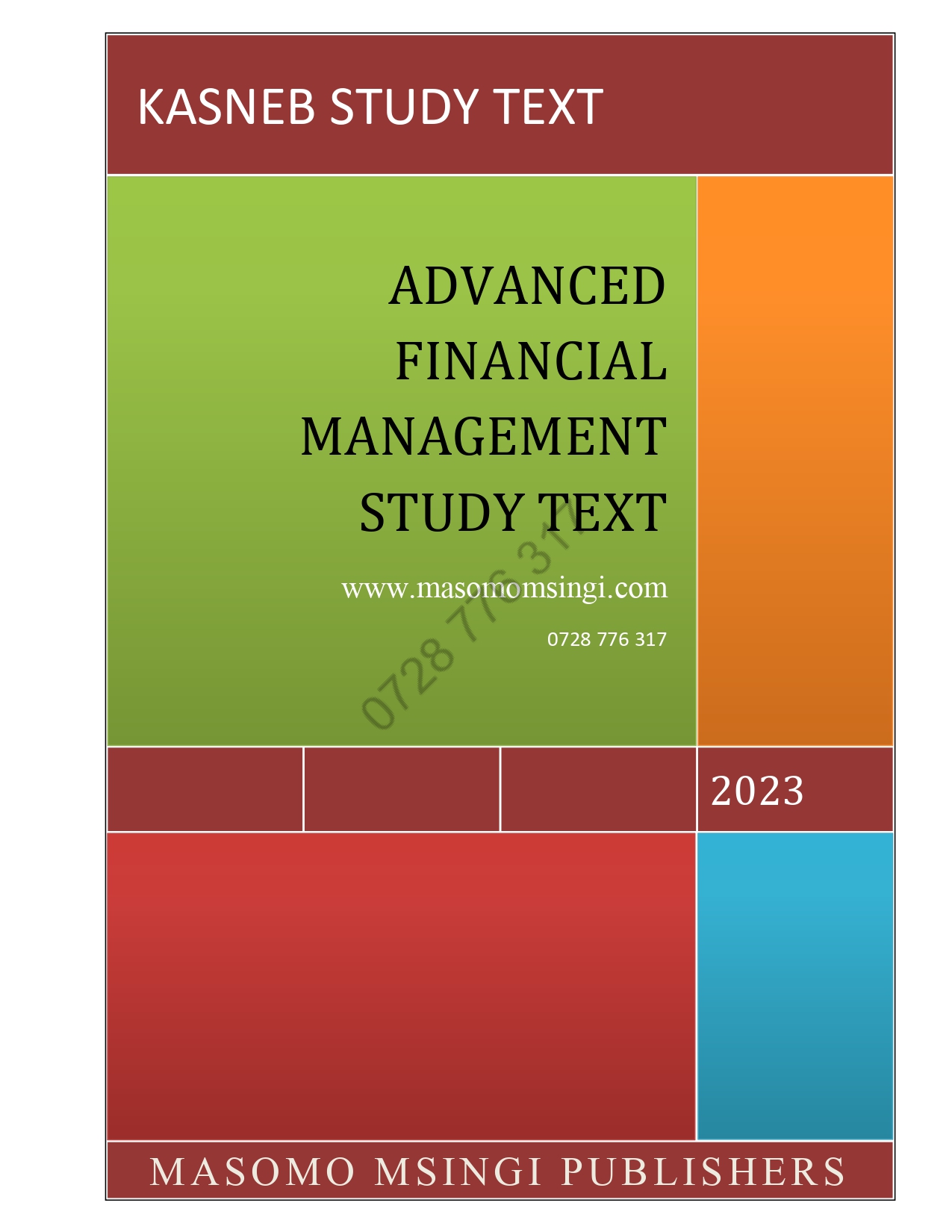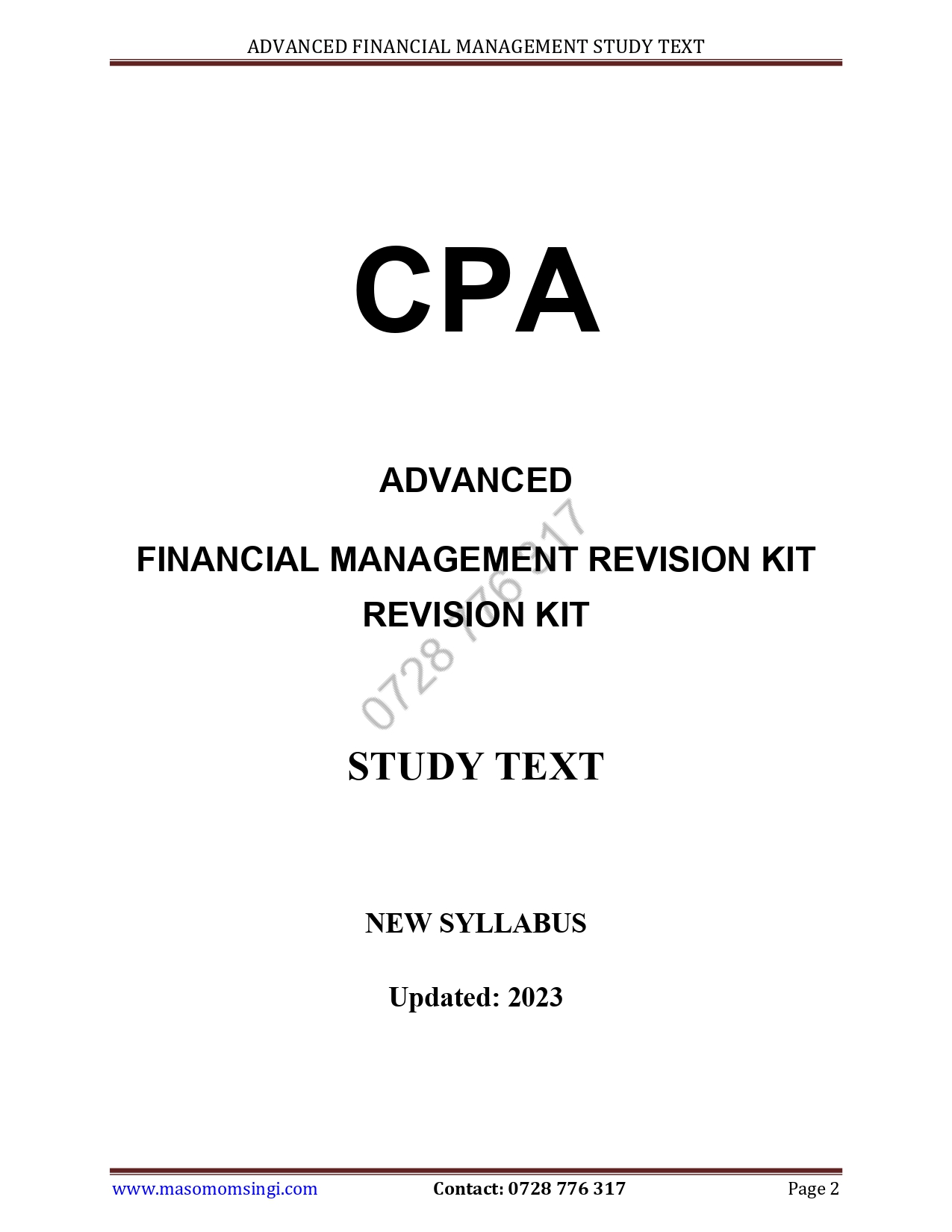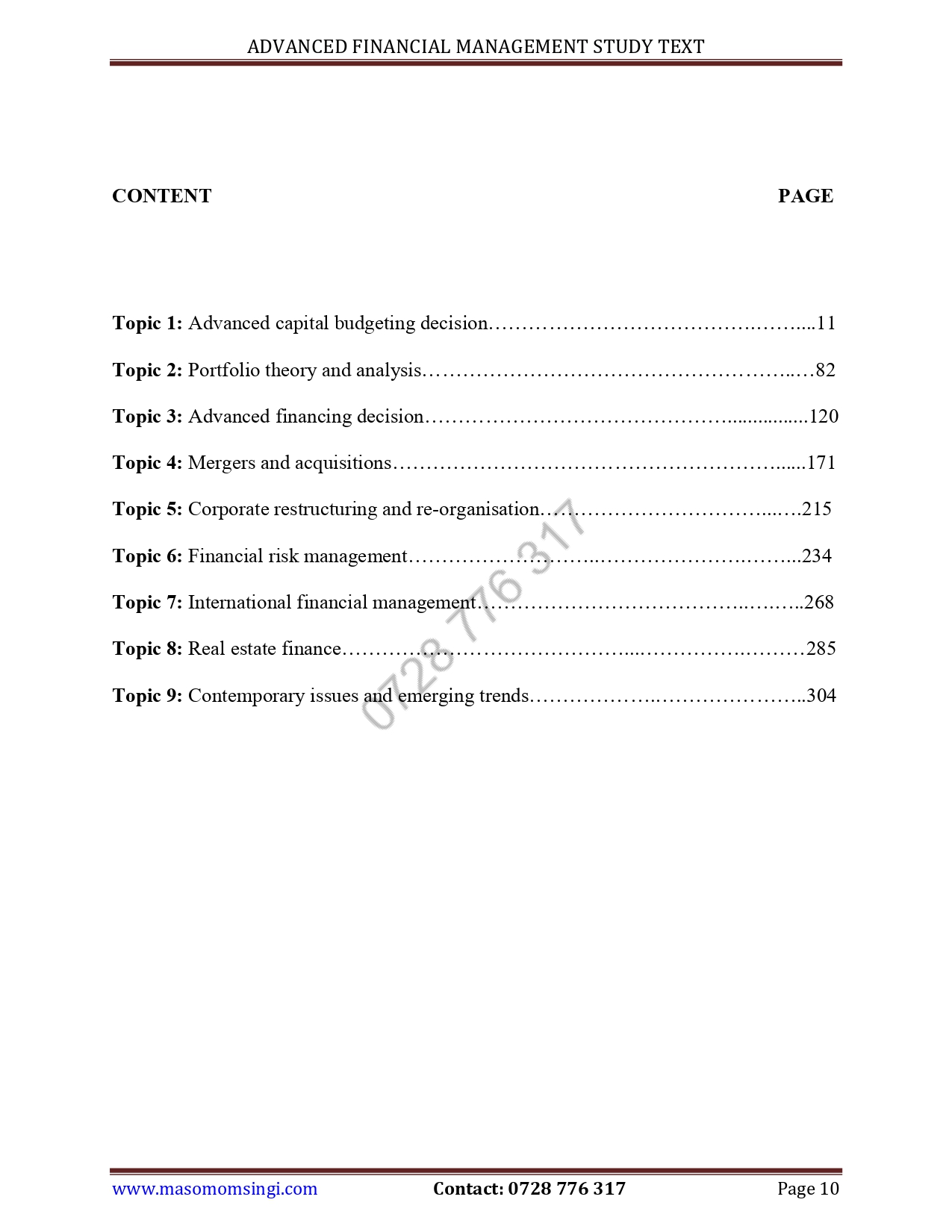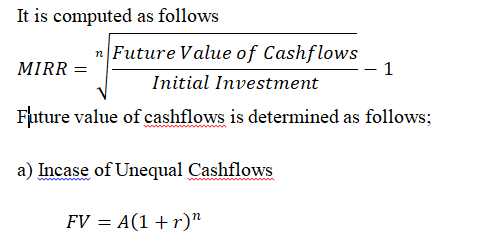

MASOMO MSINGI PUBLISHERS APP – Click to download and access all our materials in soft copies
GENERAL OBJECTIVE
This paper is intended to equip the candidate with knowledge, skills and attitudes that will enable him/her to apply advanced financial management techniques in an organisation.
15.0 LEARNING OUTCOMES
A candidate who passes this paper should be able to:
- Make advanced capital budgeting decisions and make appropriate capital structure decisions for an organisation
- Evaluate portfolios and apply the capital asset pricing model and other multifactor Models in financial decision making
- Apply the relevant models and skills in prediction of corporate failure
- Apply derivatives in financial risk management and apply international finance concepts.
- Evaluate mergers and acquisitions
- Undertake corporate restructuring and re-organisation
- Apply valuation techniques in real estate finance.
CONTENT
1 Advanced capital budgeting decision
- Incorporating risk/uncertainty in capital investment decisions
- Techniques of handling risk: Basic Methods of analysis – Expected Monetary Value (EMV), The Standard deviation and Coefficient of Variation
- Advanced Methods of analysis; sensitivity analysis, scenario analysis, decision trees, simulation analysis, utility analysis, risk adjusted discounting rate (RADR) and certainty equivalent method
- Impact of financing on investment decisions – the concept of adjusted present value (APV)
- Incorporating capital rationing in capital investment appraisal; Single period capital rationing with divisible projects; Multi-period capital rationing with divisible capital investments.
- Incorporating inflation in capital investment appraisal
- Evaluation of projects of unequal lives; The equivalent annual annuity approach and the Replacement chain analysis (Constant scale finite period replication criteria)
- Project duration as a measure of risk
- The real options in Capital Budgeting-Characteristics of the real Options; Types of Options in Capital investment Appraisal-Strategic investment option (Expansionary Option), Timing option (Option to delay a project), abandonment option (Option to Withdraw a project), the replacement option and the Option to re-deploy a project, challenges in use of options in investment analysis.
- Common capital budgeting pitfalls
2 Portfolio theory and analysis:
- The modern portfolio theory: background of the theory; portfolio expected return; the actual and weighted portfolio risk; derivation of efficient sets; the capital market line (CML) model and its applications, the mean variance dominance rule; short comings of portfolio theory
- Capital Asset Pricing Model-CAPM: background of the theory; assumptions; beta estimation – beta coefficient of an individual asset and that of a portfolio and the interpretation of the result; security market line(SML) model and its applications; conceptual differences between portfolio theory and capital asset pricing model
- Shortcomings of the capital asset pricing model
- The Arbitrage pricing model (APM) and other multifactor models: background of the theory; conceptual differences between the Capital asset pricing model and the Arbitrage pricing model; application of the Arbitrage pricing model, shortcomings of Arbitrage pricing model; Pastor Stambaugh model
- Evaluation of portfolio performance: Treynor’s measure, Sharpe’s measure, Jensen’s measure, appraisal ratio measure, information ratio, Modigliani and Modigliani (M2)
3 Advanced financing decision
- The nature of financing decision, principle objectives of making financing decision
- Analysis of breakpoints in weighted marginal cost of capital schedule (more than two breakpoints)
- Capital structure theories: nature of capital structure; factors influencing the firm’s capital structure; traditional theories of capital structure – assumptions of the theories, Net income theory and Net operating income theory; Franco Modigliani and Merton Miller’s propositions – MM without taxes, MM with corporation taxes, MM with corporation and personal tax rates and MM with taxes and financial distress costs; other theories of capital structure; the pecking order theory; Static Trade-off theory and Agency effects, determination of the firm’s optimal capital structure using the Hamada model, CAPM and WACC
- Long term financing decisions; bond refinancing decision, lease-buy evaluation and rights issues
- Assess an organisation’s debt exposure to interest rate changes using the simple Macaulay duration and modified duration methods
- Benefits and limitations of duration including the impact of convexity
4 Mergers and acquisitions
- Nature of mergers and acquisitions
- Arguments for and against the use of acquisitions and mergers as a method of corporate expansion; Acquisition and Mergers verses organic growth
- Valuation of acquisitions and mergers: problem of overvaluation; valuation models- ‘Book value-plus’ models, Market based models, cash flow models; apply appropriate methods, such as: risk-adjusted cost of capital, adjusted net present values and changing price/earnings multipliers resulting from the acquisition or merger, to the valuation process where appropriate. Prediction of a takeover target: criteria for choosing an appropriate target for acquisition
- Defence tactics against hostile takeovers
- Financing of mergers and acquisitions: Outright purchase using cash, share for share exchange, share- Debenture exchange and share- preference share exchange, Analysis of combined operating profit (EBIT) and post-acquisition earning per share at the point of indifference in firm’s earnings under various financing options and Determination of range of combined operating profit within which to recommend a financing option
- Financial Evaluation of mergers and acquisitions – Post merger/Acquisition EPS, Post Merger/Acquisition MPS
- Regulatory framework for mergers and acquisitions
- Valuation of firms/ Shares for Mergers and acquisition Purposes- Use of Net asset basis, P/E ratio basis, Dividend growth model, Super profits model, Capital asset pricing Model and the Discounted free cash flow basis.
- Reasons why there are failed mergers and acquisitions
- Mergers and acquisitions in the Kenyan, regional and global context
5 Corporate restructuring and re-organisation
- Background on restructuring and reorganisation
- Indicators/symptoms of restructuring
- Causes of financial distress
- Forms of financial distress and solutions to financial distress
- Considerations in designing an appropriate restructuring programme
- Financial reconstruction: forms of financial reconstruction; impact of financial reconstruction on share price; impact of financial reconstruction on the weighted Average cost of capital (WACC)
- Portfolio reconstruction: various ways of unbundling a firm: divestment, de-merger, spin-off, liquidation, sell-offs, equity carve outs, strategic alliances, management buyout, leveraged buyouts and the management buy-ins.
- The relevance of the various forms of portfolio reconstruction
- Organisational reconstruction: The nature and benefits of this form of restructuring
- Other forms of restructuring
- Restructuring in the Public sector
- Models of predicting corporate failure; Quantitative Models-Multiple discriminant analysis (Z-Score model), Springate model, Fulmer model; Qualitative Models – Argenti Model
6 Financial risk management
- Types of risks: operational risks, political risks, economic risks, fiscal risks, regulatory risks, currency risks and interest rate risks
- The meaning, nature and importance of derivative instruments
- Operations of the derivatives market: The relative advantages and disadvantages of exchange traded versus over the counter (OTC) agreements; Key features, such as standard contracts, tick sizes, margin requirements and margin trading
- Types of derivatives: futures, forwards, options and swaps
- Application of option pricing theory in investment decisions: Apply the Black-Scholes Option Pricing (BSOP) model to financial product valuation and to asset valuation; assumptions, structure, application and limitations of the BSOP model; calculate and advise on the value of options to delay, expand, redeploy and withdraw using the BSOP model
- Binomial Option pricing model – Use of both riskless hedge and the risk neutral approach in Valuation of both European and American call and put options
- Foreign currency risk management: Types of forex risks, hedging currency risks, forward contracts, money market hedge, currency options, currency futures and currency swaps, Bilateral and Multilateral netting and Matching tools of managing forex risks
- Option trading Strategies- Spreads and Combinations
- Limitations of financial derivatives
7 International financial management
- Introduction – The nature of international finance, Motives for investing in foreign markets and Challenges experienced by the Multinational corporations
- International financial Systems – Players in the international financial systems such as International Monetary fund, World trade organisation, European Union and the World bank.
- International trade flows and foreign direct investments (FDI)
- Financing of International Trade – Methods of financing the trade.
- International Capital and Money Markets – The foreign exchange Market-Exchange rates, Foreign Exchange exposures, International arbitrage – locational arbitrage, triangular arbitrage and covered interest arbitrage, International parity conditions- Interest rate parity, purchasing power parity and International fisher effect, International capital markets and their importance
- International Capital Budgeting – Reasons for Investing abroad, Evaluation of capital investments using local cash flows and foreign cash flows.
- International Capital structure – Factors influencing capital structure of MNCs, Sources of international finance, Cost and benefits of the alternative sources of international finance, Factors leading to difference in cost of capital of domestic firms and Multinational corporations and Adjusting WACC for risk differential
8 Real estate finance
- Overview of real estate finance – Meaning of real estate finance, nature of real estate business, property rights and limitations of property rights, environment of real estate finance and participants in real estate business.
- Real estate valuation approaches (income approach, cost approach and sales comparison approach)
- Real estate investment trusts (REITS): Types; advantages and disadvantages
- Instruments of real estate financing – mortgages, lien, title, mortgage requirements and mortgage clauses
- Mechanics of real estate mortgage-mortgage payments, mortgage constant, amortisation schedules
- Secondary mortgage trading and mortgage securitisation and re-financing
- Financing real estate investments-optimal capital structure, review of capital MM Theories in relation to real estate finance, arbitrage process
- Permanent financing of commercial real estate-equity financing, debt financing, cash flow from operations, mechanics of leasing versus ownership
9 Contemporary issues and emerging trends
- Crypto currency
- Block chain technology
- Cloud funding
- Digitisation of financial transactions
- Big data project finance
- Islamic finance
- Behavioral finance
- Derivative markets in developing countries
SAMPLE WORK
Complete copy of CPA ADVANCED FINANCIAL MANAGEMNT STUDY NOTES is available in SOFT copy (Reading using our MASOMO MSINGI PUBLISHERS APP)
Phone: 0728 776 317
Email: info@masomomsingi.co.ke

TOPIC 1
ADVANCED CAPITAL BUDGETING DECISION
Introduction
Capital budgeting (investment) decisions may be defined as the firm’s decisions to invest its current funds most efficiently in the long-term assets in anticipation of an expected flow of benefit over a series of years.
Elements/Characteristics of Capital budgeting projects
- They are long-term projects
- Benefits are realised in future
- They are highly risky
- Involves huge capital
- They are irreversible
Importance of capital budgeting
- Ensures choosing of projects which have a long term cash inflows
- Helps to control expenditures
- Helps to determine the uncertainity and risk involved in investment decisions
- Facilitates innovation and creativity thus economic growth
Types of capital budgeting decisions
- Mutually exclusive decisions/projects
Are projects that serve the same purpose and compete with each other in terms of resources i.e. if one project is undertaken then others will have to be excluded.
- Independent projects
Are projects that serve different purposes and don’t compete for resources. Therefore, they can be undertaken subject to availability of funds.
- Dependent/contingent projects/decisions
Are those projects that depend on each other thus when one is undertaken then the other will have to be undertaken.
- Divisible and indivisible projects
Divisible-Are those which generate income before they are complete
Indivisible-Don’t generate income before they are complete.
- Outright acquisition projects
It involves purchase of a new long term assets for the first time
Usually done to meet the changing need of an enterprise
- Expansion and diversification projects
Involves expanding of existing facilities which have become inadequate due to diversification into new areas of operation.
- Replacement and modernization projects
Involves replacing an existing asset which has become technologically outdated in order to modernize operations of the business
Capital budgeting process
- Project identification and generation
- Project screening and evaluation
- Project Selection
- Implementation:
- Performance review
Factors affecting budgeting capital budgeting
- Capital structure
- Working capital Capital return
- Availability of funds
- Earnings
- Lending policies of financial institutions
- Management decisions
- Project needs
- Accounting methods
- Government policy
- Taxation policy
- Project’s economic value
Objectives of capital budgeting
- Control of capital expenditure: Estimating the cost of investment provides a base to the management for controlling and managing the required capital expenditure accordingly.
- Selection of profitable projects: The company have to select the most suitable project out of the multiple options available to it. For this, it has to keep in mind the various factors such as availability of funds, project’s profitability, the rate of return, etc.
- Identifying the Right source of funds: Locating and selecting the most appropriate source of fund required to make a long-term capital investment is the ultimate aim of capital budgeting. The management needs to consider and compare the cost borrowing with the expected return on investment for this purpose.
Features/characteristics of capital budgeting decisions
- Involve huge amounts of capital
- Funds are invested in long term assets
- Future benefits will occur to the firm over a series of years
- They are usually irreversible-ones undertaken and not possible to reverse to original state involve huge loss to reverse.
- There are a lot of uncertainty involved while undertaking such projects e.g. economic life and expected cash inflows.
Importance of investment/capital budgeting decisions
Investment decision requires special attention because of the following reasons:-
- Involve commitment of large amounts of funds
- Are irreversible or reversible at huge loss
- Are among the most difficult decision to make
- They influence the firms growth in the long term
- They affect the risk of the firm
PROJECT EVALUATION TECHNIQUES
Proudly categorized in to two:
- Non-discounting techniques
- Discounting techniques
Non-discounting techniques
This techniques do not take into account time value of money. They include:-
- Payback Period
- Accounting rate of return
Discounting techniques
Techniques which take into account time value of money. They include:
- Discount payback period (DPBP)
- Net present value (NPV)
- Modified Internal rate of return (MIRR)
- Profitability Index (PI)
- The internal Rate of return(IRR)
Features/Characteristics of an ideal investment appraisal method
- It should take into account time value of money
- It should use cashflow rather than accounting profit
- It should give a clear indication on whether to accept or to reject a project
- It should consider all cashflows
- It should help in ranking independent projects
MASOMO MSINGI PUBLISHERS APP – Click to download and access all our materials in soft copies
Discount Payback Period (DPBP)
Pay back period is the length of time taken to recover the initial capital investment. The shorter the period the better and less risky the project is and vice versa
Net Present Value (NPV)
This is the most appropriate and widely applied investment appraisal method. NPV is the difference between the present value of cash and cash outflows.
Decision criteria is as follows:
- If NPV is the Positive (+ve); accept the Project
- If the NPV is Negative (-ve) Reject the project
- If NPV is Zero (0), Point of indifference
MODIFIED INTERNAL RATE OF RETURN (MIRR)
The required rate of return assuming that the cashflows generated can be re-invested to earn more returns
It is computed as follows:


Illustration
Consider a project whose initial investment is 636,000 and the company expects to generate annual cash flows of 240,000 p.a. for a period of 5 years. The present cash flows can be re- invested at the rate of 16% pa and the cost of capital is 14% .
Determine the MIRR

Accept Since MIRR> Cost of Capital
PROFITABILITY INDEX (PI)
This is the relative measure of performance. Expressed as follows:

If probability index is greater > than 1 accept the project
If profitability index is less < than 1 reject the project
PI is applied when the company is facing capital rationing
SAMPLE WORK
Complete copy of CPA ADVANCED FINANCIAL MANAGEMNT STUDY NOTES is available in SOFT copy (Reading using our MASOMO MSINGI PUBLISHERS APP)
Phone: 0728 776 317
Email: info@masomomsingi.co.ke
